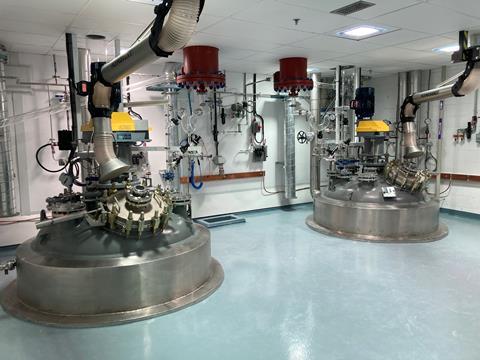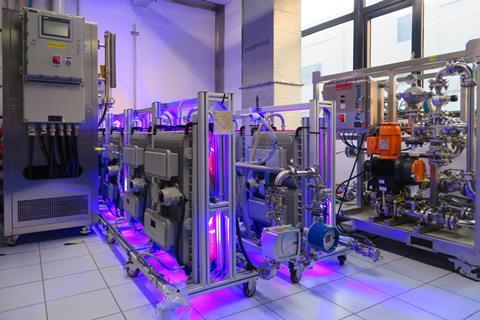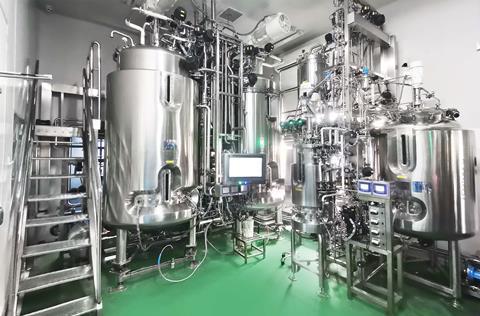Contract services firms are becoming increasingly sophisticated and embedded in the ecosystem of drug development
‘We essentially created from nothing a product ready to go into clinical testing,’ says Daniel Fitzgerald, chief executive of UK-based Halo Therapeutics about his company’s pan-coronavirus antivirals.
The biotech launched at a challenging time – in the middle of the pandemic. ‘We had an [active pharmaceutical ingredient, API] to begin with,’ explains Fitzgerald. ‘What we needed to do was formulation, chemistry, device and preparing for a clinical trial application.’ Instead of starting the costly – and lengthy – process of finding a lab space, buying in the right equipment and assembling in-house teams, ‘we developed … a drug–device combination product entirely using [contract research organisations, CROs], up to a clinical trial application’.
‘[Contract development and manufacturing organisations] are, in my opinion, the pharma industry’s special forces unit: a highly specialised team that functions behind the scenes, doing difficult tasks in high pressure situations,’ says Peter DeYoung, chief executive of one such CDMO, Piramal Global Pharma, headquartered in India.

A few decades ago, drug development was often done directly by pharma companies that commanded in-house teams of thousands of scientists. ‘Towards the mid-1990s, there was really a change,’ says Mark Chadwick, chief commercial officer of CRO Charnwood Molecular whose newest site in Loughborough, UK, used to be an AstraZeneca research facility employing 2000 people. ‘Top 10 pharma companies often had many divisions of molecular biology internally, and in the last 20 years, those divisions disappeared,’ adds Fitzgerald. ‘This was entirely outsourced, mostly to Asia, just because of price.’
For pharma based in Europe and the US looking for low cost and high expertise, CDMOs in China have long been a major source of drug precursors, while companies in India have broadly focused on finished drug products and biologics. ‘But salaries in some of the major hubs in Asia have gone up a lot and so has the cost of goods sold, so there’s some reversal,’ Fitzgerald explains.
The advantage of CROs and CDMOs is that you can look globally for the precise competencies that you need.
‘The effects of the Covid pandemic came into play here too,’ says DeYoung. ‘The market’s embrace of onshoring is real and we have responded, recognising that the definition of “which shore” varies and depends on the vantage point of our customer and their needs.’
Global, but local
Minzhang Chen, co-chief executive of China-headquartered WuXi AppTec, explains that its subsidiary, WuXi STA, is steadily increasing its global footprint across the US, Europe and Asia. It added a new drug product manufacturing facility in Switzerland in 2021. Another site, focusing on formulation development and manufacturing for oral solid and injectable drugs, is under construction in the US.
Piramal also acquired a US site specifically to address the needs for US-based drug products, DeYoung explains. ‘We’ve taken major steps in the area of supply chain security by becoming less reliant on China and rethinking the raw material pipeline.’

‘I think pharma companies have turned the corner in terms of their appetite to outsource development,’ says Eduard Viladesau, partner and associate director at Boston Consulting Group (BCG), who is the firm’s topic lead in contract manufacturing and external supply in the pharmaceutical industry. ‘The scale and scope of outsourcing has changed markedly,’ agrees Chadwick. ‘At the start of my career [in the early 2000s], I worked for a company called BioFocus (now Charles River) and drug discovery outsourcing was in its infancy. Now it is a global industry.’
Instead of one-off project transactions, there has been a move to long-term strategic partnerships between the contractors and their clients. Particularly in the biotech sector, CDMOs are often seamlessly integrated with any in-house development and manufacturing departments. Many small and virtual pharma companies, those that consist of only few employees and few, if any, facilities, could not exist without CDMOs.
One-stop shops
There is a traditional division between contract research and contract manufacturing organisations, CROs and CMOs, respectively. The former support pharmaceutical companies in their drug discovery and clinical research efforts, while the latter offer activities focused on manufacturing – both of active pharmaceutical ingredients and entire drug products, sometimes even including packaging.
But over the last five to eight years, there has been a rise of organisations that aim to be ‘one-stop shops’ for anything from early-stage research to manufacturing. ‘Whereas eight years ago the true CDMO was a myth, I think that’s not true anymore,’ says Viladesau. ‘The integration between development and manufacturing is valuable even to big pharma companies, because it really greatly reduces the tech transfer and scale up risk.’

The pandemic marked a turning point for the relationship between CDMOs and pharma companies, Viladesau and colleagues wrote in a BCG article. Pre-2020, pharma companies usually outsourced services on a project-by-project basis. Long-term partnerships were rare; around 80% lasted no longer than a few years. During the pandemic, CDMOs suddenly became a huge source of additional research and manufacturing capacity – though it remains unclear whether this will translate to more strategic collaborations in the long run.
‘The relationship has become more integrated and broader, with increasing use of [contract research, development and manufacturing organisation, CRDMO] companies from the early phases through to the complete life cycle,’ agrees Chen, who defines WuXi STA as one such CRDMO. Partnerships have shifted from transactional to strategic. ‘[This] requires that CRDMOs have development technologies, manufacturing capacities and proven quality systems, as well as the experience and expertise.’
‘For biotechs, especially virtual and emerging companies, it’s much the same, albeit deeper,’ adds DeYoung. ‘Some of those clients do not have any in-house technical infrastructure and capabilities, and definitely don’t have a deep bench of talent to rely on for specific technical needs.’ While big pharma companies often work with a different contractor for each step of the drug life cycle, smaller firms may prefer to partner with a CRDMO that offers a wider array of research and manufacturing services, says Viladesau. This lowers the burden of having to manage a complex set of partners for each individual step.
Speed and competency are the two major components when it comes to making decisions around outsourcing, Fitzgerald explains. ‘The advantage of CROs and CDMOs is that you can look globally for the precise competencies that you need. It’s difficult to build this especially if you’re a small company in one location.’
Specialist skills
The outsourcing market for biological products – sugars, proteins, nucleic acids or even whole cells and tissues – is growing at 10–15% per year, compared with 6–7% growth in small-molecule drug compounds. While new chemical entities remain the largest segment of the CDMO market, DeYoung says, ‘Biologics have been riding a wave over the last few decades and are certainly part of the change the market has experienced.’
The fastest growth, however, is happening in entirely new classes of treatment: RNA therapeutics, protein degraders, cyclopeptides, antibody drug conjugates and gene therapy. ‘They are very highly outsourced, because normally they’re very small, so for every individual pharma player it rarely makes sense to invest in building a whole plant,’ says Viladesau.
I can’t see us going back to a situation where a pharma company employs thousands of scientists – I think that world has gone.
These new modalities require a completely different set of equipment and expertise than traditional drug molecules or even biologics. Moreover, the new modalities market encompasses so many different technologies, it would be nearly impossible for a single company to develop expertise in all of them – and bear all the financial risk for drugs failing. But with the help of specialist CDMOs, firms can dip in and out of different therapeutic fields. ‘It’s difficult to see a trend yet, given it’s already heavily outsourced,’ Viladesau points out.
Despite this propensity for outsourcing, when one of these new products turns out to be a clear winner, originator companies will probably eventually invest in in-house manufacturing, Viladesau suggests. ‘Because even for all the talk about CMOs being capable, there is still a preference by pharma companies to own the manufacturing capability.’
Here to stay
Multiple, interconnected factors continue to drive growth in outsourcing services. Chadwick points to pharma firms’ efforts to maximise value for shareholders; Fitzgerald highlights aspects of cost and technological advancements. DeYoung notes that large firms want to reduce their assets and costs, while emerging companies want to hit milestones as quickly and efficiently as possible, ‘even if it means failure’. The average number of drug approvals by the US Food and Drug Administration almost doubled between 2011 and 2021 compared with the previous decade, and that increase is associated with more demand for outsourcing and more opportunities for deeper integration into the pharmaceutical ecosystem.
Drugs featuring complex molecules and substances require investment in new technologies, says Chen – a decision that may be more easily made by a specialist CRDMO than a pharma company. WuXi STA has recently added an injectable platform for small molecules and new modalities. Piramal has added capabilities in peptide APIs and biologics. ‘CRDMO companies will continue to evolve in the next few years, investing in cutting edge science and technologies to enable innovation, such as targeted protein degradation and photoredox chemistry,’ Chen says.
‘More generally, the pharmaceutical industry has understood that specialist companies can often be more productive than internal resources in the R&D process,’ says Chadwick. ‘Specialist CROs often see many projects across a number of targets and therapeutic areas, whereas employees working in a small or large pharmaceutical company may focus on a particular area.’ He suggests the CDMO market will continue to grow over the next five to 15 years. ‘I can’t see that going back to a situation where a pharma company employs thousands of scientists – I think that world has gone.’

















1 Reader's comment